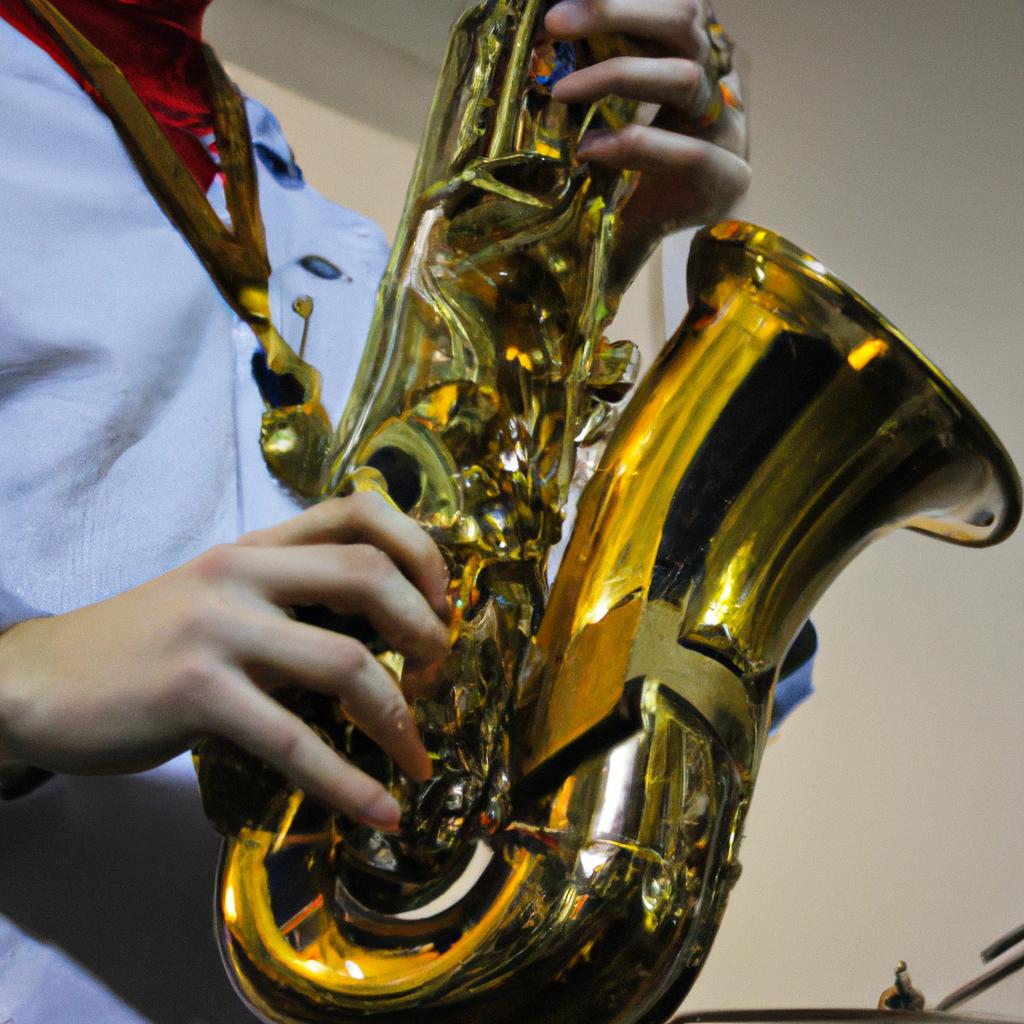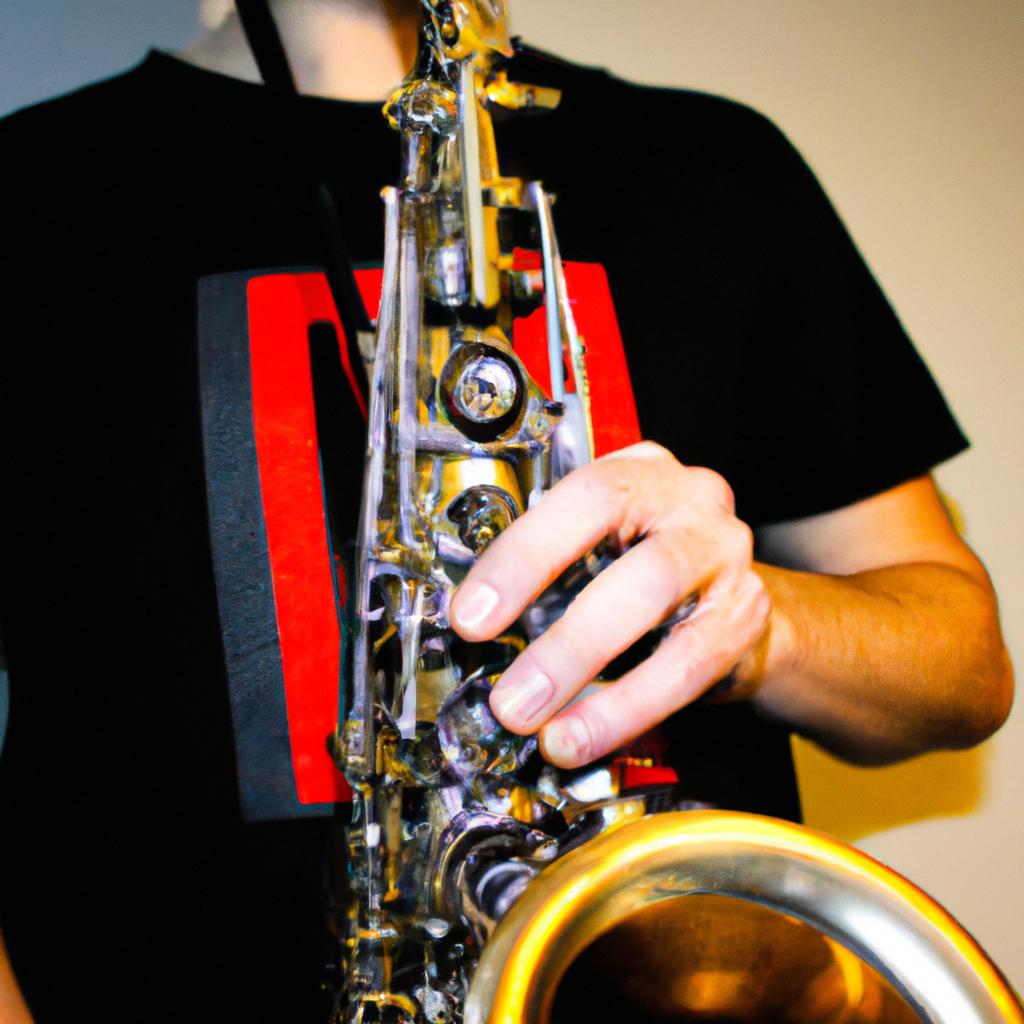Fusion in jazz represents the artistic convergence of different musical styles, resulting in a unique and dynamic genre that has captivated audiences for decades. This article explores the concept of fusion in jazz, examining how diverse influences have shaped the evolution of this genre. By analyzing one particular case study – Miles Davis’ seminal album “Bitches Brew” – we will delve into the innovative techniques and experimental approaches employed by musicians to create a seamless blend of disparate elements.
The fusion movement in jazz emerged during the late 1960s and early 1970s as artists sought to break away from traditional boundaries and explore new sonic possibilities. It involves combining various genres such as rock, funk, R&B, Latin, and classical music with traditional jazz elements. One notable example that exemplifies fusion is Miles Davis’ groundbreaking album “Bitches Brew.” Released in 1970, it revolutionized the genre by incorporating electronic instruments, unconventional song structures, and improvisation inspired by free jazz. Through its use of studio production techniques and extensive post-production editing, “Bitches Brew” blurred the lines between composition and improvisation, creating an entirely new soundscape that challenged established notions of what constituted jazz music.
The Origins of Fusion in Jazz
The Origins of Fusion in Jazz
Jazz fusion, a genre that emerged in the late 1960s and early 1970s, represents an artistic convergence of jazz with elements from various other musical styles. This blending of genres gave birth to a new sound that pushed the boundaries of traditional jazz, incorporating rock, funk, and even classical music influences. To illustrate this concept, let us consider Miles Davis’ groundbreaking album “Bitches Brew,” released in 1970.
“Bitches Brew” stands as a prime example of how fusion transformed jazz into a more experimental and innovative form. By fusing together elements of rock and African rhythms with improvisational jazz techniques, Davis created a revolutionary album that challenged listeners’ perceptions of what jazz could be. The use of electric instruments such as guitars and keyboards further added depth to the overall sonic landscape, creating a unique listening experience for audiences.
To fully appreciate the impact of fusion on jazz, it is important to understand the emotional response it evokes in its listeners. Through one’s engagement with fusion music, they may feel:
- Excitement: The dynamic energy present in fusion compositions can ignite feelings of thrill and anticipation.
- Intrigue: The infusion of diverse musical elements creates an air of curiosity and intrigue within the listener.
- Empowerment: Fusion’s ability to break away from convention empowers individuals by encouraging them to explore unconventional ideas.
- Connection: Fusion’s amalgamation allows for cross-cultural connections, fostering unity among diverse communities.
Furthermore, analyzing key characteristics through comparison helps bring out the essence of fusion in relation to traditional jazz styles. Consider the following table highlighting distinct traits found in each genre:
| Traditional Jazz | Fusion Jazz |
|---|---|
| Emphasis on swing rhythm | Experimentation with complex time signatures |
| Acoustic instrumentation | Incorporation of electronic instruments |
| Clear song structures | Extended improvisations and free-form compositions |
| Traditional harmonic progressions | Exploration of unconventional harmonies |
As we delve deeper into the development of fusion jazz, it becomes evident that its origin lies in a desire to break away from established norms. This section has laid the groundwork for understanding how fusion began reshaping the landscape of jazz music. In exploring key influences on this genre, we will further uncover the transformative power behind fusion’s evolution.
Transitioning seamlessly into our next section, let us now explore the key influences that propelled fusion jazz forward.
Key Influences on Fusion Jazz
Fusion in Jazz: The Artistic Convergence
The Origins of Fusion in Jazz explored the historical context and pivotal moments that led to the emergence of this innovative genre. Now, we will delve into the key influences on fusion jazz, shedding light on how various musical traditions converged to shape its unique sound.
One notable example illustrating the convergence of different musical styles in fusion jazz is the collaboration between Miles Davis and John McLaughlin on their album “Bitches Brew.” Released in 1970, this groundbreaking work fused elements of jazz, rock, and Indian classical music. By incorporating electric instruments, unconventional song structures, and improvisation techniques from diverse genres, Davis and McLaughlin created a sonic landscape that captivated audiences around the world.
To further understand the influences that shaped fusion jazz, consider these four key factors:
- Exploration of new tonalities: Fusion musicians sought to break away from traditional harmonic conventions by experimenting with dissonance and unconventional chord progressions.
- Integration of non-Western musical traditions: Artists drew inspiration from global cultures, infusing their compositions with elements such as African rhythms or Middle Eastern scales.
- Technological advancements: The advent of electric instruments allowed for greater experimentation with timbre and sound manipulation.
- Socio-political climate: Fusion arose during a time when social upheaval was widespread; artists used their music as a means to express dissent and reflect societal changes.
In order to visualize the multifaceted nature of influence in fusion jazz, let us examine some examples within a table:
| Influences | Description | Impact |
|---|---|---|
| Rock | Incorporating distorted guitar tones and driving rhythms added an energetic edge to fusion jazz compositions | Enhanced intensity |
| Funk | Infused groovy basslines and syncopated drum patterns brought infectious danceability to fusion tracks | Invoked a sense of rhythm and groove |
| Classical | Borrowed compositional techniques, like orchestration and counterpoint, added complexity and depth to fusion compositions | Provided a rich harmonic foundation |
| World Music | Incorporating diverse musical traditions from around the globe introduced new melodic patterns, rhythms, and scales into fusion jazz pieces | Broadened the cultural palette of fusion |
In summary, fusion jazz emerged as an artistic convergence influenced by various factors. Through exploration of tonality, integration of non-Western music traditions, technological advancements, and reflection of socio-political climate, artists created a genre that pushed boundaries while resonating with listeners worldwide.
The subsequent section will delve into the characteristics that define fusion jazz without skipping a beat in our analysis of this captivating genre.
Characteristics of Fusion Jazz
Fusion in Jazz: The Artistic Convergence
Key Influences on Fusion Jazz have paved the way for a unique and innovative genre that continues to captivate audiences worldwide. Building upon the foundations of traditional jazz, fusion jazz incorporates elements from various musical styles such as rock, funk, and world music. This section will explore the characteristics that define fusion jazz, highlighting its dynamic nature and artistic convergence.
One notable example of fusion jazz is Miles Davis’ groundbreaking album “Bitches Brew.” Released in 1970, this album exemplifies the fusion movement by blending electric instruments with traditional jazz instrumentation. By incorporating elements of rock and avant-garde music, Davis pushed the boundaries of what was considered acceptable within the realm of jazz at the time. His experimentation and willingness to embrace new sounds set a precedent for future generations of fusion artists.
To further understand the characteristics of fusion jazz, it is important to examine its key features:
- Hybridization: Fusion jazz combines diverse musical genres to create a complex yet harmonious sound. It seamlessly fuses elements from different traditions, resulting in an amalgamation that transcends conventional boundaries.
- Improvisation: As with traditional jazz, improvisation plays a vital role in fusion jazz. Musicians are given freedom to experiment and express themselves through spontaneous solos and collective improvisations.
- Groove-oriented rhythm: Fusion jazz often emphasizes rhythmic patterns derived from funk and other popular styles. Powerful bass lines, syncopated drumming, and infectious grooves form the backbone of many fusion compositions.
- Technological innovation: The use of electronic instruments and effects pedals distinguishes fusion jazz from its predecessors. Electric guitars, synthesizers, and electronic keyboards contribute to its distinctive sonic landscape.
Table: Key Characteristics of Fusion Jazz
| Characteristic | Description |
|---|---|
| Hybridization | Combination of diverse musical genres |
| Improvisation | Spontaneous solos and collective improvisations |
| Groove-oriented rhythm | Emphasis on rhythmic patterns derived from funk and popular music |
| Technological innovation | Incorporation of electronic instruments and effects pedals |
The artistic convergence found within fusion jazz has allowed musicians to explore new sonic territories, challenge traditional norms, and create a genre that continues to evolve. By embracing various musical influences, fusion artists have expanded the possibilities of jazz, attracting audiences with its dynamic energy and innovative spirit.
Transitioning into the subsequent section about “Notable Fusion Jazz Artists,” it is important to acknowledge the influential figures who have shaped this genre throughout history. These artists have pushed boundaries, leaving an indelible mark on the world of jazz through their unique contributions.
Notable Fusion Jazz Artists
Fusion jazz, with its unique blend of various musical genres, has brought about an artistic convergence that continues to captivate both musicians and audiences alike.
One prominent example is the legendary guitarist John McLaughlin and his band Mahavishnu Orchestra. Formed in the early 1970s, they were at the forefront of fusing elements from rock, jazz, and classical music. Their groundbreaking album “The Inner Mounting Flame” showcased intricate compositions infused with complex time signatures and virtuosic improvisations. This innovative approach to blending diverse musical styles became a hallmark of fusion jazz.
To better understand the impact of fusion jazz on listeners, let us explore four key emotional responses it can evoke:
- Excitement: Fusion jazz often features high-energy performances filled with thrilling solos and dynamic interplay between instruments.
- Intrigue: The combination of different musical traditions creates a sense of curiosity as listeners try to identify familiar elements within unfamiliar contexts.
- Euphoria: The sheer joy derived from witnessing skilled musicians effortlessly navigate through complex harmonies and rhythms can be truly uplifting.
- Reflection: Fusion jazz also offers moments of introspection through slower-paced compositions that allow for contemplation and emotional connection.
Furthermore, we can examine these emotional responses by considering a table showcasing three influential fusion jazz albums along with their corresponding emotions evoked:
| Album | Emotions Evoked |
|---|---|
| “Bitches Brew” | Intrigue, Euphoria |
| “Weather Report” | Excitement, Reflection |
| “Head Hunters” | Excitement |
In conclusion, fusion jazz represents an artistic convergence that pushes boundaries by combining various musical genres into a cohesive whole. Through artists like John McLaughlin and albums such as “Bitches Brew,” “Weather Report,” and “Head Hunters,” fusion jazz has the power to evoke excitement, intrigue, euphoria, and reflection in its listeners. This emotional impact is a testament to the genre’s ability to transcend traditional musical boundaries.
Looking ahead, we will now explore the profound impact of fusion jazz on the music world by delving into how it influenced other genres and shaped future musical developments.
Impact of Fusion Jazz on the Music World
Fusion in Jazz: The Artistic Convergence
Notable Fusion Jazz Artists have played a significant role in shaping the genre and pushing its boundaries. Their innovative approach to blending different styles and genres has resulted in groundbreaking music that continues to captivate audiences worldwide.
One such example is Miles Davis, a trailblazer in fusion jazz who transformed the genre with his seminal album “Bitches Brew” released in 1970. This album fused elements of rock, funk, and traditional jazz, creating a unique sound that challenged conventional notions of what jazz could be. Davis’ ability to seamlessly integrate these diverse musical influences set a new standard for future fusion artists.
The impact of fusion jazz on the music world cannot be overstated. It has not only influenced other genres like rock, pop, and electronic music but also expanded the possibilities within jazz itself. Here are some key ways in which fusion jazz has made an indelible mark:
- Blurring Genre Boundaries: Fusion jazz blurred the lines between various musical genres by incorporating elements from rock, funk, R&B, and world music into its sound. This cross-pollination created fresh sonic landscapes that appealed to a broader audience.
- Expanding Instrumentation: Fusion jazz introduced unconventional instruments such as synthesizers, electric guitars, and drum machines into traditional jazz ensembles. This expansion of instrumentation opened up new avenues for experimentation and creative expression.
- Embracing Technology: Fusion artists embraced technological advancements like recording techniques and electronic effects pedals. These tools allowed them to manipulate sounds in unprecedented ways, giving rise to innovative textures and atmospheres.
- Collaborative Approach: Fusion jazz fostered collaboration among musicians from different backgrounds and disciplines. By bringing together artists with diverse perspectives, fusion became a platform for cultural exchange and artistic exploration.
Table: Evolutionary Influences in Fusion Jazz
| Influences | Characteristics | Example Artists |
|---|---|---|
| Rock | Powerful guitar riffs | John McLaughlin |
| Funk | Groove-oriented rhythms | Herbie Hancock |
| R&B | Soulful vocals | George Duke |
| World Music | Ethnic instruments and scales | Chick Corea |
As fusion jazz continues to evolve, its future remains an open canvas. The genre’s ability to adapt and incorporate new influences ensures that it will remain relevant in the ever-changing music landscape. In the subsequent section on “The Future of Fusion in Jazz,” we will explore how contemporary artists are pushing boundaries even further and shaping the next chapter of this captivating genre.
The Future of Fusion in Jazz
The influence of fusion jazz on the music world has been profound, igniting a creative explosion and redefining the boundaries of traditional genres. One notable example is the collaboration between renowned jazz pianist Herbie Hancock and hip-hop group The Roots in their 2010 album “The Imagine Project.” This groundbreaking project showcased the seamless merging of jazz, hip-hop, and various global styles, captivating audiences worldwide with its innovative sound.
This convergence of musical styles has led to several significant impacts within the music world:
- Expansion of Audience: Fusion jazz has attracted listeners from diverse backgrounds who may not have previously engaged with either genre individually. By combining elements from different traditions, fusion jazz has created a unique sonic experience that appeals to a broad spectrum of music enthusiasts.
- Cross-Cultural Exchange: Through fusing different musical cultures together, fusion jazz acts as a catalyst for cross-cultural exchange and dialogue. It encourages musicians to explore new artistic landscapes by incorporating influences from around the globe, fostering cultural understanding and appreciation.
- Evolution of Improvisation: Fusion jazz has pushed the boundaries of improvisation techniques, challenging musicians to think outside conventional harmonic structures. This evolution in improvisational approaches has contributed to an overall advancement in instrumental skills across various genres.
- Inspiration for Future Artists: The success and impact of fusion jazz have inspired future generations of artists to experiment with blending disparate genres. This ongoing exploration continues to shape contemporary music and paves the way for innovation beyond established conventions.
Table: Notable Fusion Jazz Albums
| Album | Artist | Year |
|---|---|---|
| “Bitches Brew” | Miles Davis | 1970 |
| “Head Hunters” | Herbie Hancock | 1973 |
| “Heavy Weather” | Weather Report | 1977 |
| “Black Market” | Weather Report | 1976 |
This table showcases a selection of notable fusion jazz albums that have left a lasting impact on the music industry. Each album represents a unique amalgamation of styles and serves as an inspiration for both musicians and listeners alike.
In summary, fusion jazz has had a profound impact on the music world, breaking traditional boundaries and fostering innovation. By expanding audiences, encouraging cross-cultural exchange, evolving improvisation techniques, and inspiring future artists, fusion jazz continues to shape the musical landscape with its artistic convergence.
[Next Section: The Future of Fusion in Jazz]




